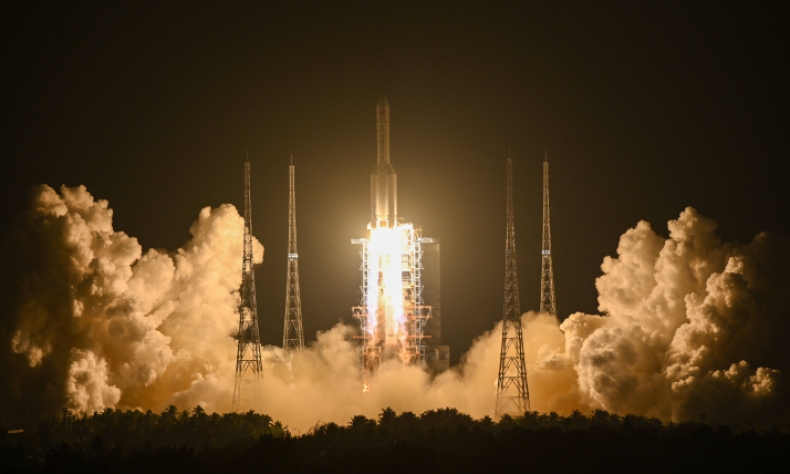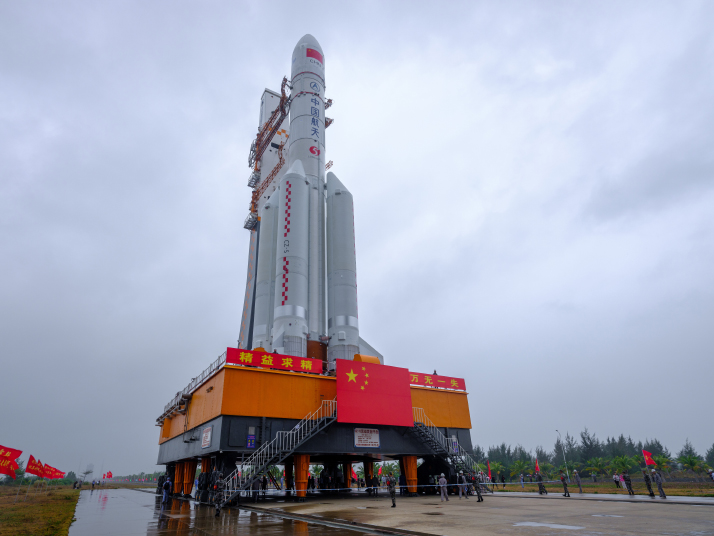The Phoenix Reborn

The successful flight of Long March-5 Y3 advances China’s space exploration program
The Chang’e-4 lunar probe’s landing on the far side of Moon was a good start to China’s performance in aerospace in early 2019, while the liftoff of the third Long March-5, also known as Long March-5 Y3, saw a remarkable ending. The flawless liftoff overcame the most difficult problem in the country’s carrier rocket history.
China’s largest carrier rocket
The 57-meter Long March-5 Y3 is the largest carrier rocket in China. It has a 5-meter diameter core stage, 10 engines and four boosters. The rocket weighed nearly 870 tons when it was launched, with a thrust of over 1,000 tons.
It blasted off at 8:45 p.m. on December 27, 2019 from the Wenchang Satellite Launch Center in Hainan Province in south China.
After a huge flame and white flashlight, it soared into the sky carrying the Shijian-20, the heaviest domestic communications satellite with the most advanced technologies. The satellite was sent into the geosynchronous orbit 3,600 km above Earth, marking the success of the flight after 2,220 seconds.
At that moment, Wang Weibin, deputy chief designer of the project, finally felt relieved and smiled. He sat in the same seat where 908 days ago, he had seen the failure of the second Long March-5, whose engines were designed by his team.
The rocket has completely independent intellectual property rights. In addition to boosting confidence, it also laid the foundation for China’s long-term space dream. With the launch, China made 32 successful rocket launches in 2019, ranking first in the world.
Reborn from failure
It took 10 years to carry out the maiden flight.
The concept of the Long March-5 came from Chinese rocket scientists in 1986. After 20 years of technological preparations, the rocket’s research and development (R&D) program was approved and started in 2006 at the China Academy of Launch Vehicle Technology (CALT), a Beijing-based subsidiary of the state-owned space conglomerate China Aerospace Science and Technology Corp. Generally, the proportion of new technology is below 30 percent in the R&D of a new launch vehicle. But with the Long March-5, it reached 95 percent. As a result, its R&D workload was four to five times that of other rockets without extending the development cycle.
To complete the tough task, a team of 10,000 engineers, whose average age is under 35, participated in the project. Besides, new digital technologies were applied to shorten time and decrease costs of R&D.
While the first vehicle accomplished its mission in November 2016, the second carrier rocket failed. On July 2, 2017, it suddenly began to fall at the 346th second because the engines stalled. Wang said it was hard to believe it because it had never happened in previous 120 ground tests. “It looked normal and no changes were observed,” he explained.
The incident happened in space and the debris fell into the Pacific Ocean, raising the bar for the follow-up. The scientists had to do more simulations, calculations and ground tests. But the same fatal problem was confirmed on November 30, 2018. It was the result of structural abnormalities in the engines at the first core stage. Although the improved engines passed the later tests, other issues related to engines were discovered before the final launch.
The Long March rockets use new eco-friendly fuel that comprises kerosene, liquid hydrogen and liquid oxygen, instead of toxic propellants. Some suggested redesigning the engines, which would take two years longer and would also delay subsequent space plans. The team decided to fix the defects in the original version and strengthen the engines.
Li Dong, chief designer of the Long March-5 Y3 rocket, told Xinhua News Agency the project team and a large number of scientists from domestic institutions and enterprises improved the design, materials and technologies. Over 1,000 experiments were conducted to check for errors.

Reaching for the stars
The Long March-5 Y3 rectified over 200 key technological problems in its design and manufacturing. Also, 26 components, three main engines and software were upgraded to enhance its quality.
The progress represents the highest level in China’s rocket technology, and the engineers are proud to participate in the development, Qu Yiguang, deputy general director of the research team, told Xinhua.
A larger payload is a highlight of the Long March-5 Y3 since it will support deeper exploration of space. The team decided to expand its stage diameter to provide more space for fuel. Its design workload is over 3.5 times that of the previous Long March rockets. This is the reason this new generation of carrier rockets looks stronger than others.
The third Long March-5 is capable of carrying spacecraft weighing up to 25 tons—roughly the combined weight of 16 midsize cars—to a low-Earth orbit, or 14 tons to a geosynchronous transfer orbit. For coming missions, it can transport an eight-ton probe to an Earth-Moon transfer orbit or a five-ton probe to an Earth-Mars transfer orbit.
The capacity equals that of other mainstream large-scale rockets in the global industry, greatly improving China’s ability to launch spacecraft and laying the foundation for developing new-generation carrier rockets and heavy-lift launch vehicles, Wang Xiaojun, head of CALT, told Xinhua.
This flight verified the engineering adjustments made to improve the rocket’s overall design, as well as key technologies to be used in the journey to Moon by the Chang’e-5 probe. In 2020, the Long March-5 will send the probe to Moon and a rover to Mars, he said, adding that the rockets to be used on these missions are in the assembly and testing phases.
 Facebook
Facebook
 Twitter
Twitter
 Linkedin
Linkedin
 Google +
Google +










